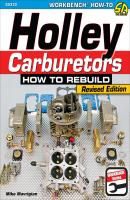Holley Carburetors. Mike Mavrigian
Чтение книги онлайн.

Читать онлайн книгу Holley Carburetors - Mike Mavrigian страница 2
Название: Holley Carburetors
Автор: Mike Mavrigian
Издательство: Ingram
Жанр: Сделай Сам
isbn: 9781613253144
isbn:
Basic Hand Tools
Specialty Tools
Chemicals
Drill Bits
Torque Wrench
Cleaning Chemicals
Media Blasting
Measuring Tools
Chapter 5: Carburetor Disassembly
Fuel Inlet Removal
Fuel Bowl Removal
Metering Bowl Disassembly
Float Removal
Needle and Seat Removal
Accelerator Pump Removal
Accelerator Pump Discharge Nozzle Removal
Jet Removal
Power Valve Removal
Overflow Whistle Removal
Mixture Screw Removal from Metering Block
Choke Assembly Removal
Vacuum Secondary Diaphragm Removal
Main Body and Baseplate Separation
Chapter 6: Cleaning and Inspection
Solvents
Cracks and Pinholes
Baseplate
Main Body
Power Valve
Throttle Plates
Choke Fast-Idle Cam
Throttle Shaft and Shaft Bearings
Idle and Main Well Passages and Emulsion Tubes
Accelerator Pump Diaphragm
Needle and Seat Assembly
Main Jets
Discharge Nozzles
Carburetor Renewal Kits
Chapter 7: Assembly
Main Body to Throttle Body Baseplate
Metering Block Assembly
Accelerator Pump Installation
Float Installation
Metering Block Installation
Fuel Bowl Installation
Discharge Nozzle Installation
Choke Installation
Vacuum Secondary Installation
Secondary Metering Plate Installation
Carb-to-Intake Installation
Chapter 8: Preparation and Tuning
Torque Requirements
Linkage Setup
Engine Pre-Start Requirements
Emergency Precautions
Vacuum Leaks
Throttle Operation
Fuel Pressure
Carburetor Plumbing Techniques
Dyno Testing Your Setup
Pre-Oiling a Fresh Engine
Air Cleaners
Float Height
Idle Mixture
Engine Bogs
Power Valve
Tuning Vacuum Secondary Operation
Appendix: Holley Carburetor Models, Part Numbers and Features
Source Guide
Thanks to the following for their assistance in producing this book: Bill Tichenor, Holley; Dave Monyhan, Goodson Tools; Scott Gressman, Gressman Powersports; Brian Carruth, Trick Flow Specialties; Scott Koffel, Koffel’s Place; Tony Lombardi, Ross Racing Engines; Trey, AED; Diro Ahart, CRC; Bob Harris, Lisle Corp.; Robert Holmes, Mac Tools; Thor Schroeder, Moroso; Alan Rebescher, Summit Racing; Willy, Willy’s Carbs; Lista International; and Jody Holtry, Medina Mountain Motors.
During the 1950s and 1960s, the Holley 4-barrel carburetor established itself as the clear leader in high-performance operation because it provided precise fuel metering in low-, mid-, and high-RPM operation. Also, it was a modular design that was easy to tune and had a wide range of parts. The Holley 4150-series, or Double Pumper, carburetor distinguished itself during the muscle car era because it had an accelerator arm pump on both float bowls, so if the carburetor were used for aggressive acceleration or wide-open throttle, it would deliver all the needed fuel into the engine when called upon.
Although the basic architecture of the Holley 4-barrel carburetor has remained largely the same for 60 years, Holley has offered several different series of carburetors, such as the 4150, 4160, Avenger, and Dominator. And of course, many different carburetor models exist within these series. In this book, I review Holley carb styles, models, features, and sizes, so you can accurately identify your particular carburetor and its parts.
Many classic cars, muscle cars, hot rods, street rods, and competition cars are equipped with Holley carburetors. If you have an OEM Holley carburetor, it is most likely 30 years or older. Over time, gaskets deteriorate and bushings wear and possibly leak, metering blocks and jets are exposed to contaminants and become plugged, jet needles and jets wear from use and no longer meter properly. If you have an aftermarket carburetor, it may be newer but a lot of usage may require a rebuild. Or possibly, you СКАЧАТЬ